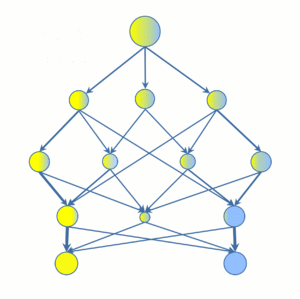Decision stream graph facts for kids
Imagine you want a computer to make smart decisions, like figuring out if an email is spam or predicting how much a house might cost. That's where a Decision Stream comes in! It's like a special kind of flowchart or map that helps computers learn from information and make predictions.
Think of it as a series of "if-then" rules. For example, "IF the email has 'free money' in the subject, THEN it's probably spam." A Decision Stream uses many of these rules, linked together, to solve problems. It's built on ideas from decision trees, which are common in computer science.
One cool thing about Decision Streams is how they handle information. Sometimes, regular decision trees can run out of data as they try to make very specific rules. This is called "data exhaustion." Decision Streams avoid this by cleverly combining different parts of the "map" (called "nodes" or "leaves") to make sure there's always enough information to make good decisions. This helps the computer learn better and make more accurate guesses.
Contents
What is a Decision Stream?
A Decision Stream is a powerful tool used in artificial intelligence and machine learning. It helps computers learn from data to solve two main types of problems:
- Classification: This is when you want to sort things into different groups. For example, classifying animals as mammals or birds, or deciding if a customer will buy a product.
- Regression: This is when you want to predict a number. For instance, predicting the temperature tomorrow, or estimating the price of a car based on its features.
How Does It Work?
A Decision Stream uses a series of simple questions or rules to guide it. Each question leads to another, until a final decision or prediction is made. It's like playing a "20 Questions" game with data.
For example, if you're trying to classify fruits:
- Is it red? (Yes/No)
- If yes, is it round? (Yes/No)
- If yes, does it have a stem? (Yes/No)
- If yes, it might be an apple!
The "stream" part means that the decisions flow in one direction, without loops. This makes it easy for the computer to follow the path and reach a conclusion.
Why Are Decision Streams Useful?
Decision Streams offer several important benefits that make them a great choice for many tasks. They help computers learn more effectively and make better predictions.
High Accuracy
Decision Streams are very good at making correct predictions. They use special statistical tests to split data very precisely. Imagine you have a big pile of mixed toys. A Decision Stream uses exact measurements to sort them into the right bins. This careful sorting means the computer makes fewer mistakes. It helps the model understand the data better.
Avoiding Overfitting
Sometimes, a computer model can learn the training data too well. It might memorize the examples instead of understanding the general rules. This is called "overfitting." When this happens, the model won't work well on new, unseen data.
Decision Streams help prevent overfitting. They only divide the data into groups that are "statistically representative." This means they only create new rules if there's enough clear evidence in the data. It's like a teacher who only makes a new rule for the class if most students agree it's fair. This makes the model more flexible and reliable for new information.
Reduced Complexity
As a computer model learns, it can sometimes become very complicated. Imagine a giant, tangled web of rules. This can make it hard to understand why the computer made a certain decision.
Decision Streams are designed to keep things simpler at each step. They try to find the clearest and most straightforward rules possible. This means the overall model is easier to understand and manage. It's like breaking down a big, tough problem into smaller, easier steps.
Self-Regulated Depth
Some computer models need you to tell them exactly how many layers or steps they should have. But with Decision Streams, the model figures this out on its own. It decides how deep or detailed its rules need to be based on the data.
This "self-regulated depth" means the Decision Stream stops learning new rules when it no longer helps. It won't keep adding unnecessary complexity. It's like knowing when to stop asking questions because you already have enough information to make a good choice. This makes the learning process more efficient.
How Decision Streams Compare to Decision Trees
Decision Streams are an advanced version of traditional decision trees. Both use a tree-like structure to make decisions. However, Decision Streams solve a key problem that decision trees sometimes face.
The Problem of Data Exhaustion
In a standard decision tree, as you go deeper into the tree, the amount of data at each "leaf" (the final decision point) gets smaller and smaller. Eventually, you might not have enough data to make a reliable decision. This is "data exhaustion." It's like trying to make a big decision with only a tiny bit of information.
Decision Streams fix this by "merging" leaves. This means they can combine information from different parts of the tree. This ensures that even at the very end of the decision process, there's still enough data to make a strong, reliable prediction. This merging makes the Decision Stream more robust and accurate, especially with complex data.
Real-World Examples
Decision Streams, and similar machine learning models, are used in many parts of our daily lives:
- Spam Filters: They help your email program decide if an incoming message is junk mail.
- Medical Diagnosis: They can help doctors identify potential diseases based on patient symptoms.
- Financial Fraud Detection: Banks use them to spot unusual transactions that might be fraud.
- Recommendation Systems: When a streaming service suggests a movie you might like, it's often using similar learning methods.
By understanding how tools like Decision Streams work, you can see how computers are becoming smarter and more helpful in solving real-world problems.


